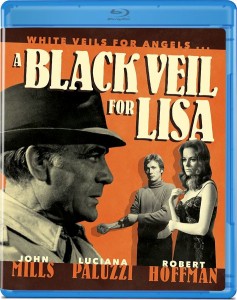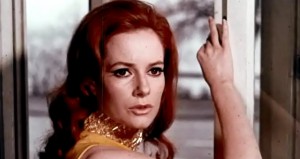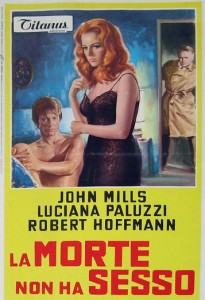As a fan of Italian “giallo” flicks, it’s always enjoyable to catch up with titles that have fallen between the cracks. One such film is A Black Veil for Lisa, a pulpy thriller directed by Massimo Dallamano, the director of photography on Spaghetti westerns A Fistful of Dollars (1964) and For a Few Dollars More (1965).
 Set in Germany, the tale follows a narcotics inspector named Bulon (John Mills). He’s on the lookout for hitman Max Lindt (Robert Hoffmann) who’s been bumping off witnesses who can pin point the criminal behind the drug trade. But he’s got other problems, namely his much younger wife, Lisa (Luciana Paluzzi). Bulon is certain she’s cheating on him, but can’t seem to prove it. And she appears to be bored and frustrated with him, although the marriage appears to be cracking due to Bulon’s insecurities and controlling nature.
Set in Germany, the tale follows a narcotics inspector named Bulon (John Mills). He’s on the lookout for hitman Max Lindt (Robert Hoffmann) who’s been bumping off witnesses who can pin point the criminal behind the drug trade. But he’s got other problems, namely his much younger wife, Lisa (Luciana Paluzzi). Bulon is certain she’s cheating on him, but can’t seem to prove it. And she appears to be bored and frustrated with him, although the marriage appears to be cracking due to Bulon’s insecurities and controlling nature.
But it’s what happens next that ends up becoming most interesting. When Bulon finally catches up to his target, he decides not to take him in. Instead, he gives the assassin the opportunity chance to avoid incarceration… that is, if he agrees to take out a hit on Lisa. Of course, Lindt agrees to kill the wife, but soon finds himself enraptured by the woman’s feminine wiles. Paluzzi was a Bond girl in the film Thunderball (1965), and she plays the femme fatale role expertly.
 It all gets a little silly and doesn’t provide much more than B-movie thrills, but it certainly includes some clever visual flourishes that help elevate the material. We often get brief flashes into the head of the increasingly jealous and panicked Bulon as he imagines his wife cheating on him. These jarring interludes are a nifty trick that really establish the investigator’s deteriorating mental state.
It all gets a little silly and doesn’t provide much more than B-movie thrills, but it certainly includes some clever visual flourishes that help elevate the material. We often get brief flashes into the head of the increasingly jealous and panicked Bulon as he imagines his wife cheating on him. These jarring interludes are a nifty trick that really establish the investigator’s deteriorating mental state.
And there are plenty of other examples of stylish photography. There’s a great Split Diopter shot that suggests to the sense of tension and separation between husband and wife. Dallamano also appears to like using wide-angle lenses, and it creates an impressive sense of distortion, particularly during a fight in a tight and enclosed ship hull. Additionally, there’s some moody nighttime photography that certainly hints at the type of visuals that would become commonplace only a few years later.
 Of course, the murders themselves aren’t graphic, but one can see hints of elements that would soon be exaggerated and elaborated upon in a few years by filmmakers like Dario Argento (The Bird With the Crystal Plumage, Deep Red). It does build up some momentum in its second half, and while the ending isn’t revelatory, the concept does allow for a few more twists and turns than one would have initially expected.
Of course, the murders themselves aren’t graphic, but one can see hints of elements that would soon be exaggerated and elaborated upon in a few years by filmmakers like Dario Argento (The Bird With the Crystal Plumage, Deep Red). It does build up some momentum in its second half, and while the ending isn’t revelatory, the concept does allow for a few more twists and turns than one would have initially expected.
A Black Veil for Lisa isn’t a classic, but it’s an interesting curiosity, an early step in the evolution of Italian “giallo” thrillers. Those who really enjoyed the 70s wave of suspense/mystery/horror films that followed will definitely see hints of what’s to come in this pulpy effort and at the very least, enjoy the impressive photography and wild 60s European fashions on display.


